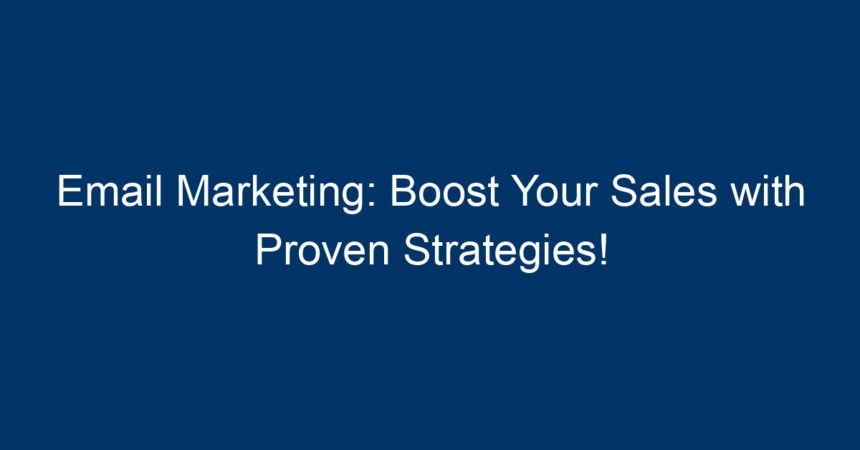In today’s digital age, email marketing remains one of the most powerful and cost-effective tools for driving sales and cultivating customer relationships. With a staggering ROI of up to $42 for every dollar spent, it’s no wonder businesses are leveraging email marketing to expand their reach. However, not every email campaign achieves the desired results. To truly boost your sales, you need proven strategies that resonate with your audience. In this article, we’ll explore effective techniques to enhance your email marketing efforts, driving engagement and conversion.
Understanding Email Marketing
What is Email Marketing?
Email marketing is the process of sending targeted messages to a specific audience via email. It can range from sharing newsletters to promotions, product announcements, and personalized recommendations. It’s a direct line to your customers and potential customers, offering an unparalleled opportunity to engage.
The Importance of Email Marketing
Email marketing allows businesses to communicate directly with their audience, build relationships, and maintain a loyal customer base. It’s particularly desirable because of its high return on investment, measurable outcomes, and the ability to segment audiences based on behavior and preferences. By leveraging email marketing, companies can boost brand awareness, drive traffic to their websites, and ultimately increase sales.
Proven Strategies for Effective Email Marketing
1. Build Your Email List Strategically
A robust email list is the backbone of your email marketing strategy. Here are a few proven methods to grow your list:
- Offer Value: Provide incentives such as discounts, free trials, or exclusive content in exchange for email sign-ups.
- Utilize Landing Pages: Create specific landing pages designed to capture email addresses. Ensure they’re linked to your promotions or value propositions.
- Leverage Social Media: Promote your email sign-up on social media platforms to capture a wider audience.
2. Personalize Your Emails
Personalization can significantly increase engagement rates. Here are some effective methods:
- Use Names: Address your subscribers by their first names to create a personal touch.
- Segment Your Audience: Divide your email list into segments based on demographics or behaviors. Tailor your content to suit each segment’s preferences.
- Behavioral Triggers: Send automated emails based on user actions, such as cart abandonment or product views.
3. Craft Compelling Subject Lines
Your email’s subject line is the first impression you make, so make it count! Here are some tips:
- Be Direct and Clear: Let readers know what to expect in the email.
- Use Curiosity: Pose questions or create a sense of urgency to encourage opens.
- Keep It Short: Aim for 50 characters or less to ensure your subject line is fully visible.
4. Optimize Content for Value
The content within your emails must provide value to encourage engagement. Consider these strategies:
- Interactive Elements: Incorporate elements like polls or surveys to engage your audience.
- Visuals and Design: Use images and a responsive design that’s visually appealing. A well-structured email can enhance readability.
- Call to Action (CTA): Include strong, clear CTAs that guide readers toward the next step, whether that’s making a purchase or visiting your website.
5. Test and Analyze Your Campaigns
Testing is crucial in email marketing. Here’s how to optimize your campaigns:
- A/B Testing: Experiment with different subject lines, content, and CTAs to find what resonates best with your audience.
- Analyze Metrics: Monitor open rates, click-through rates (CTR), conversion rates, and unsubscribe rates. These metrics can provide insight into what’s working and what needs improvement.
- Adjust Based on Feedback: Listen to subscriber feedback to refine your approach.
Advanced Email Marketing Techniques
1. Automated Email Campaigns
Automation allows you to send timely messages without constant manual effort. Common automated campaigns include:
- Welcome Emails: A warm greeting can set the tone for your relationship with new subscribers.
- Follow-up Emails: Send follow-ups after purchases or site visits to keep your brand fresh in their minds.
2. Integrate with Social Media and Content Marketing
Your email marketing efforts should complement your other marketing channels:
- Cross-Promotion: Use social media to drive email sign-ups. Conversely, promote your social channels within emails.
- Content CTA: Direct your readers to blog posts or videos related to the email content.
3. Use Email Marketing to Enhance Customer Lifecycle
Different stages of the customer journey require different approaches:
- New Subscribers: Provide value-rich content to nurture new leads.
- Active Customers: Send personalized recommendations based on purchase history.
- Lapsed Customers: Implement re-engagement campaigns with exclusive offers to win them back.
Compliance and Best Practices
1. Understand Legal Requirements
While email marketing offers tremendous opportunities, it’s vital to adhere to laws such as the CAN-SPAM Act and GDPR:
- Consent: Always obtain explicit permission to send emails.
- Opt-Out Options: Provide clear options for unsubscribing from your emails.
2. Maintain a Healthy List
Regularly clean your email list to remove inactive subscribers. This practice can improve your delivery rates and overall engagement.
Conclusion: Ready to Take Action?
Email marketing remains one of the most potent tools to drive sales and build relationships. By understanding your audience and implementing proven strategies, you can maximize the effectiveness of your campaigns. Remember to:
- Build a quality email list.
- Personalize your communications.
- Craft compelling subject lines.
- Provide valuable content and strong CTAs.
- Continuously test and analyze your efforts.
Whether you’re a seasoned marketer or just starting, these actionable insights will help you enhance your email marketing strategy and ultimately boost your sales. Dive in, engage your audience, and watch those conversions rise!




